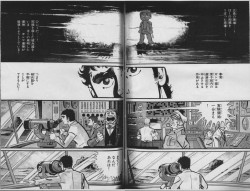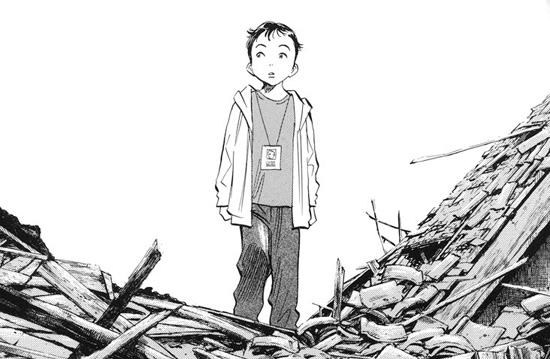
Lone Wolf and Cub 06: Lanterns for the Dead
June 28th, 2009 Posted by david brothersLone Wolf and Cub volume 6: Lanterns for the Dead
Writer: Kazuo Koike
Artist: Goseki Kojima
Publisher: Dark Horse Comics
ISBN: 1569715076
288 pages
(Pardon this being a little late again– I may move it to Sunday@6 instead of noon, depending on how this week goes. Blame the podcast, which took forever to edit!)
Volume 6 has five tales: “Lanterns for the Dead,” “Deer Chaser,” “Hunger Town,” “The Soldier Is In The Castle,” and “One Stone Bridge.” Once again, Daigoro provides the most interesting stories or scenes in the book, this time in “Hunger Town” and “One Stone Bridge,” with a brief appearance in “Deer Chaser.” I’ll get to those at the end, though, while I look at the other stories.
Notable, if delayed, realization this week: Ogami Itto is invincible, except when fighting nature or himself. The man has walked through a forest of blades at this point in the series, and escaped basically unscathed. The only time he ends up flat on his back is when he gets sick, or when he sets an entire field of grass on fire to trap a target, and then fights inside those flames.
I can see why Frank Miller enjoys these stories so much. Ogami is the manliest man ever, incredibly secure in his choice of livelihood, devoted to his task and family, and able to spout off important facets of his ideology at a moments notice. Every in the book spends their time being afraid of him, in awe, complimenting his skill, or all three. He spends a portion of “The Soldier Is In The Castle” explaining “kanjo,” which can mean either shield or warriors, depending on the situation (though the two are inextricably linked), to a gang of skilled and respected warriors. Though they brought it up first, he understands it better than they do. He employs a technique called “kanjo satsujin,” which I believe means “Warrior Killer” or “Shield Breaker” if you want to get lyrical, and destroys his enemy by way of a fire trap and skilled swordsmanship.
“Hunger Town” doesn’t focus directly on Daigoro, but he’s used to emphasize the crap nature of their lives. It opens with Ogami firing blunt arrows at a small puppy. He’s training the dog to dodge arrows and run to Daigoro. Of course, Daigoro is three years old and he gets attached to the dog. It’s clear that they have a real friendship growing, and Daigoro almost, but not quite, pitches a fit when the dog is taken away by samurai.
Ogami was setting a trap for a lord who is a fan of Inu-oi, dog hunting for sport. Most people use blunt arrows when doing this, but the lord is so corrupt that he uses real arrows for a thrill. His men demand Daigoro’s dog and deliver it to their lord. He gets set up in the area where he practices inu-oi, shouts the equivalent of “PULL!” and the dog dashes off. The lord tries and tries to hit the dog with his arrows, but the dog dodges all of them and sprints into the woods. The lord follows.
As soon as I realized what was going on, I became certain that the dog would die. In a completely unsurprising move, I was right. The dog catches an arrow through the neck just as he reaches Daigoro, licks Daigoro’s nose, and dies. Daigoro simply watches the lord as he approaches with something like pure hate in his eyes. It’s very clear that he’s his father’s son in this instance.
Another scene where that becomes clear is in “One Stone Bridge.” Daigoro is catching fish under a bridge. He’s amassed a pretty small collection, but he’s made the rod, stolen hair from a horse’s tail for fishing line, and dug up worms for bait himself. He’s trying to feed his father, who has been sick after the events of “The Soldier Is In The Castle” and unconscious for days. All the fish Daigoro has caught and grilled (!) sit beside his bed, untouched. However, he fishes every day.
When boys come to harass him, he takes their taunts and a beating to protect the fish. When they kick the fish back into the river and go back to beating him, he goes and grabs his father’s sword, which is taller than he is, and moves to kill the boy.
It’s awful, but I like seeing how strong the bond is between Daigoro and Ogami. Their lives are in terrible shape, and the only thing either of them have is each other. So, their bonds are amazingly strong. Daigoro is a very bright boy, smart enough to have been a scholar in another world, and capable of judging a situation correctly. He was willing to take a beating to protect his father, smart enough to realize that feeding his father was important, and a volume back, wise enough to build a fire break and save his own life.
There’s a word for this, I’m sure, but I don’t know it. It’s really nice to see a book that’s as much about the relationship between father and son as it is about the father killing several dozen people at a time.








































